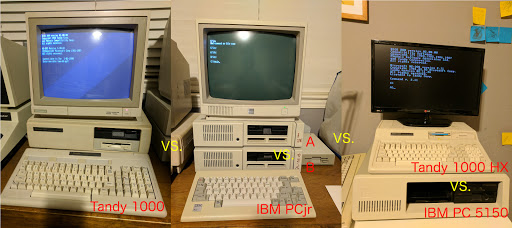
It’s well-known that you should measure the performance of your code, and not rely only on the opcode’s “cycle counts”.
But how fast is an IBM PC 5150 compared to a PCjr ? or to a Tandy 1000? or how
fast is the Tandy 1000 HX in fast mode (7.16Mhz) compared to the slow mode (
4.77Mhz) ? Or how fast is a nop compared to a cwd ?
I created a test ( perf.asm) that measures the performance of different opcodes and run it on different Intel 8088 machines. I run the test multiple times just to make sure the results were stable enough. All interrupts were disabled, except the Timer (of course). And on the PCjr the NMI is disabled as well.
Without further ado, here are the results:
And these are my conclusions:
- As expected, 1-byte size + 3-cycles opcodes are the fastest:
nop,xchg ax,xx,inc ax(note thatnopis literally axchg ax,ax) - 2-byte + 2-cycle opcodes (like
mov al,al) are twice as slow as the 1-byte + 3-cycle opcodes. - CPU intensive instructions like
mulanddivperform exactly the same in all machines. Cycle-eaters don’t affect them that much (kind of expected). - In theory, the 7.16Mhz Tandy 1000 HX should be 50% faster than the 4.77Mhz
mode. And that’s true for CPU-intensive opcodes like
mulanddiv. But opcodes that are “cycle-eaters”-bound the performance gain is 0% in most of them. - IBM PCjr vs. IBM PCjr: The PCjr could be by far the slowest of the 4.77Mhz
machines, or the fastest:
- When running code in the first 128 Kb RAM the performance is terrible! A
simple
mov al,alis 2.6 times slower! This is due to additional wait-states. - On the other hand, when running code above the 128 Kb RAM, it is the fastest (albeit by a tiny bit).
- When running code in the first 128 Kb RAM the performance is terrible! A
simple
- One of my IBM PCjr is a tiny bit faster than the other one. Couldn’t find out why. The CPU is the same, same clock speed. Something in the bus (?) perhaps ? It is faster enough to break some cycle-dependent code.
- From fastest to slowest:
- IBM PCjr (code running above 128 Kb RAM)
- IBM PC 5150 (tiny bit slower)
- Tandy 1000 (tiny bit slower)
- Tandy 1000 HX 4.77Mhz-mode (tiny bit slower)
- IBM PCjr (code running below 128 Kb RAM) (slower by a huge margin)
One opcode that is worth-noting is cwd:
- It is a 1-byte size, 5 cycles opcode
- It is a tiny bit slower than a
nop - The negative side is that it destroys
axanddx
What I like about it, is that it is between 7%~17% slower than a nop (
depending on the machine).
And when doing timing dependent code, sometimes you
need an opcode that is just a tiny bit faster or slower than another one. In my
case, I was able to have a stable raster bar on the Tandy 1000 thanks to it (
more on this in a future post).